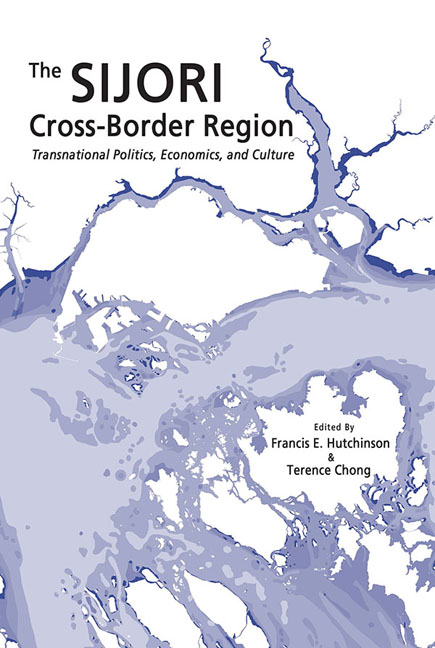Book contents
- Frontmatter
- Contents
- List of Maps
- List of Tables
- List of Figures
- Foreword
- Acknowledgements
- Contributors
- Abbreviations
- Introduction
- Section I Understanding the Whole
- Section II Policy and Politics
- Section III Cross-Border Social and Cultural Communities
- Section IV Formal and Informal Economies
- Map5
- 13 The Airport and the Territory: Transnational Flows in the Singapore- Johor-Riau Cross-Border Region
- 14 Revisiting Industrial Dynamics in the SIJORI Cross-Border Region: The Electronics Industry Twenty Years On
- 15 Development in Johor and Singapore's Water Access: Challenges and Opportunities
- 16 The Role of Ethnic Chinese Business Networks in the Regionalization Strategy of Singaporean Fish Farming Firms
- 17 Pirates and Law Enforcement Agencies: Complex Relations Across the Malacca Straits
- Conclusion
- Appendix
- Sources for the SIJORI Maps
- Index
16 - The Role of Ethnic Chinese Business Networks in the Regionalization Strategy of Singaporean Fish Farming Firms
from Section IV - Formal and Informal Economies
Published online by Cambridge University Press: 22 July 2017
- Frontmatter
- Contents
- List of Maps
- List of Tables
- List of Figures
- Foreword
- Acknowledgements
- Contributors
- Abbreviations
- Introduction
- Section I Understanding the Whole
- Section II Policy and Politics
- Section III Cross-Border Social and Cultural Communities
- Section IV Formal and Informal Economies
- Map5
- 13 The Airport and the Territory: Transnational Flows in the Singapore- Johor-Riau Cross-Border Region
- 14 Revisiting Industrial Dynamics in the SIJORI Cross-Border Region: The Electronics Industry Twenty Years On
- 15 Development in Johor and Singapore's Water Access: Challenges and Opportunities
- 16 The Role of Ethnic Chinese Business Networks in the Regionalization Strategy of Singaporean Fish Farming Firms
- 17 Pirates and Law Enforcement Agencies: Complex Relations Across the Malacca Straits
- Conclusion
- Appendix
- Sources for the SIJORI Maps
- Index
Summary
INTRODUCTION
The commercial success of ethnic Chinese firms (especially those from East Asia) during the post-World War II decades has sparked considerable research into their management models. The focus is devoted particularly to the Asian economies where the ethnic Chinese constitute a considerable portion of the entrepreneurial class, with ethnic Chinese share of market capitalization amounting to: 81 per cent in Singapore and Thailand; 73 per cent in Indonesia; 69 per cent in Malaysia; and 50 to 60 per cent in the Philippines (e.g. Jomo and Folk 2003; Menkhoff and Gerke 2002; Redding 1990; Tsui-Auch 2004). Despite the seriousness of the 1997 Asian Financial Crisis and the 2008 Global Economic Crisis, many of these ethnic Chinese firms have weathered the fallout relatively well and continued to thrive in their business ventures. Some scholars (the culturalists) have attributed the success of the ethnic Chinese firms and entrepreneurs to a unique “cultural” capacity for them to cooperate amongst themselves as they are grounded in “a set of beliefs and values which lies behind the behaviour of Chinese businessmen” (Redding 1990, p. 79). However, there is another school of thought (the institutionalists) that unpacks such activities by considering the shifting institutional contexts that these firms are embedded in, while not entirely negating the “cultural” aspects of the ethnic Chinese (e.g. Gomez 2002; Verver and Dahles 2013). Put another way, the “bamboo network” must not be viewed purely along ethnic lines for it is also shaped by business and political expediency in the specific Asian economies (Tipton 2009). Detailing the internationalization of Singapore's ethnic Chinese firms that have invested into the neighbouring Southeast Asian economies, this chapter shows that these perspectives exist side-by-side and produce a multiplicity of business linkages and power relations, all of which are deployed whenever the need arises.
While Singapore has established itself as a prominent investor since its independence in 1965, particularly to neighbouring Southeast Asian economies, there is relatively little research that focuses on the food fish farming industry. In addition, there is also a paucity of analysis that links the outward foreign direct investment (FDI) movement of the Singaporean firms to the state-society relations of the city-state. Consequently, one is left wondering about the relationship between state policies (such as those pertaining to ethnic ties) and firm dynamics, and how this shapes the industrial structure of the Singaporean food fish farming industry.
- Type
- Chapter
- Information
- The SIJORI Cross-Border RegionTransnational Politics, Economics, and Culture, pp. 411 - 430Publisher: ISEAS–Yusof Ishak InstitutePrint publication year: 2016

